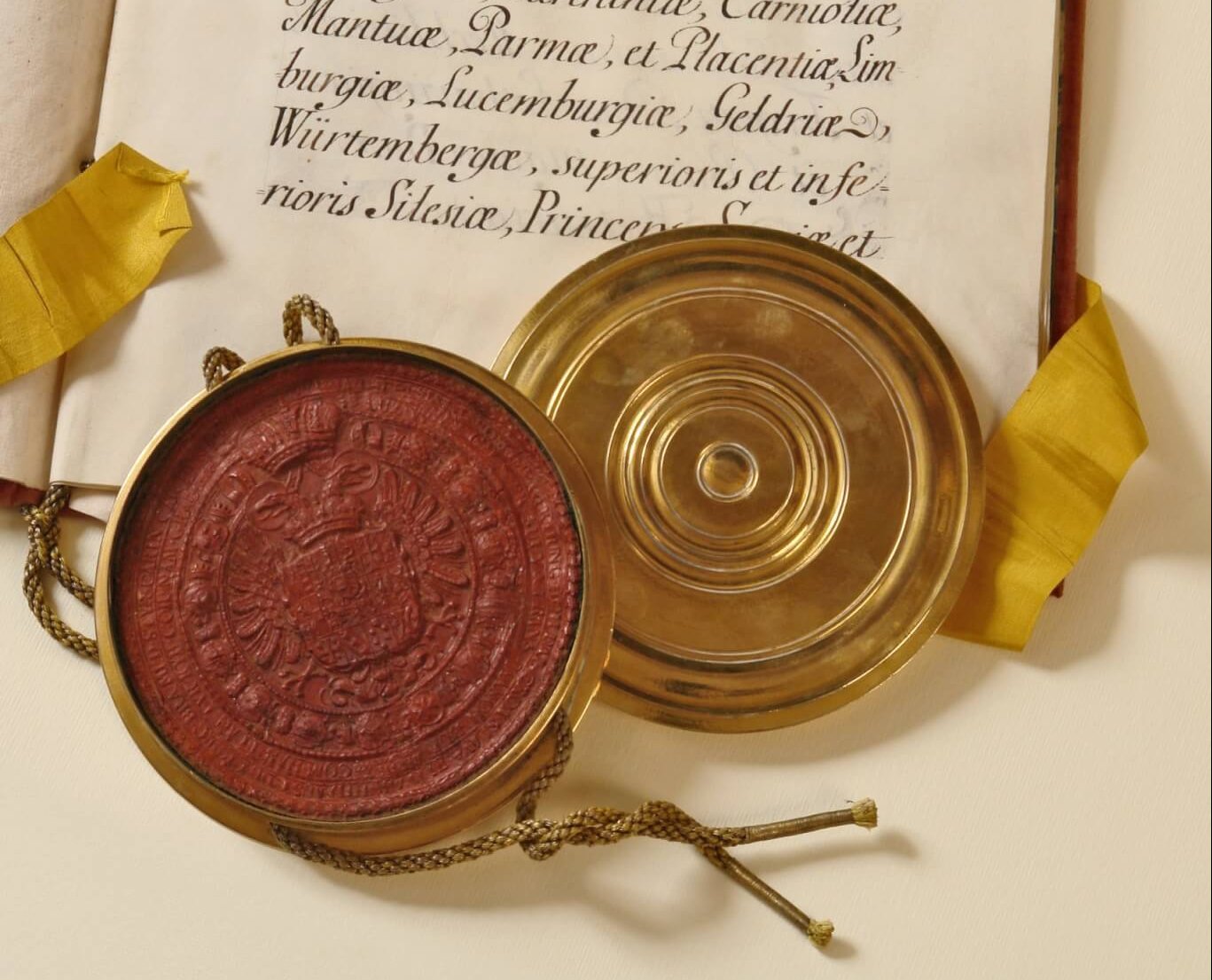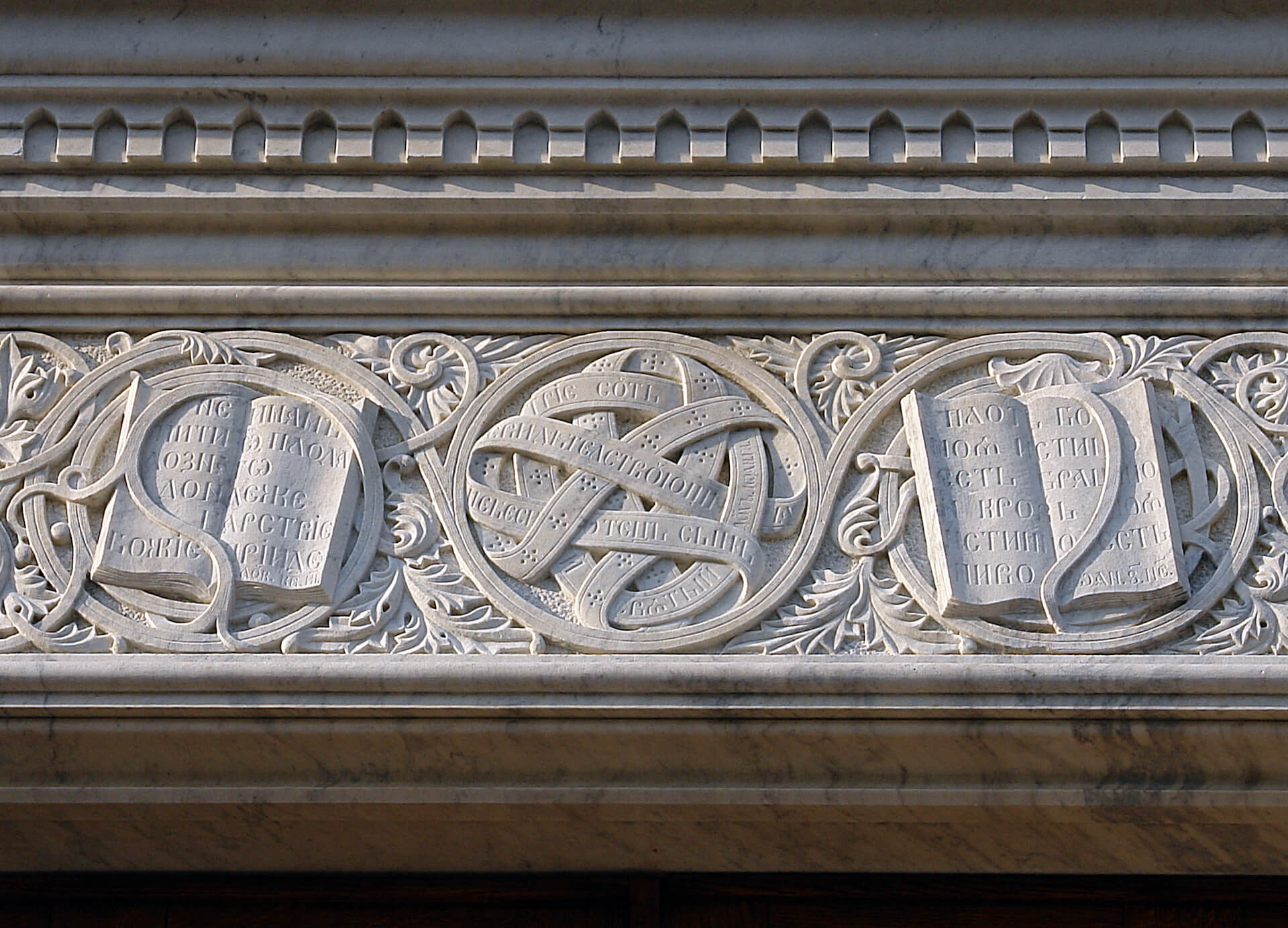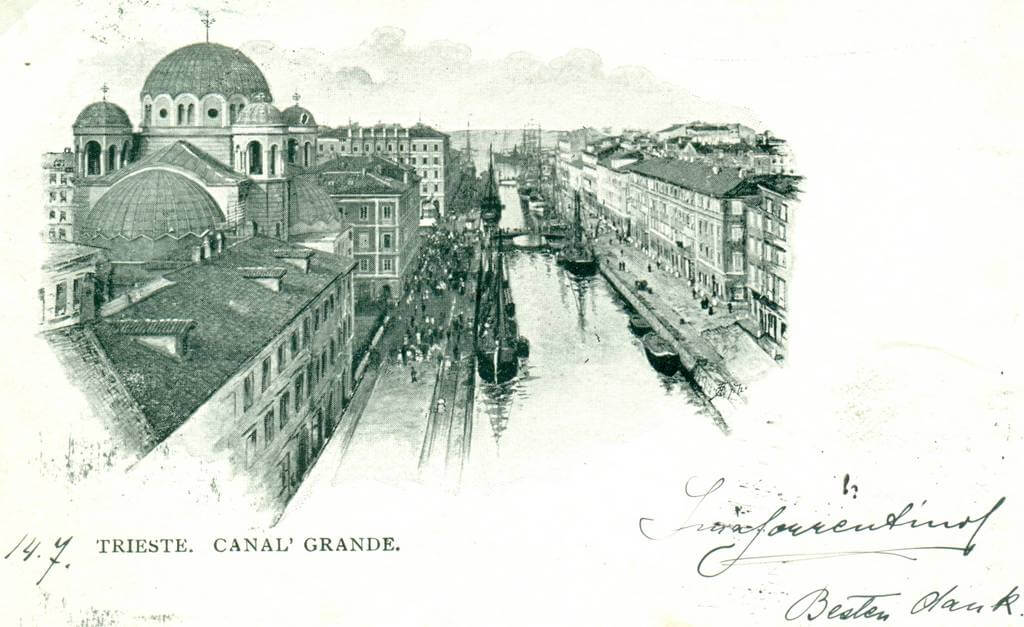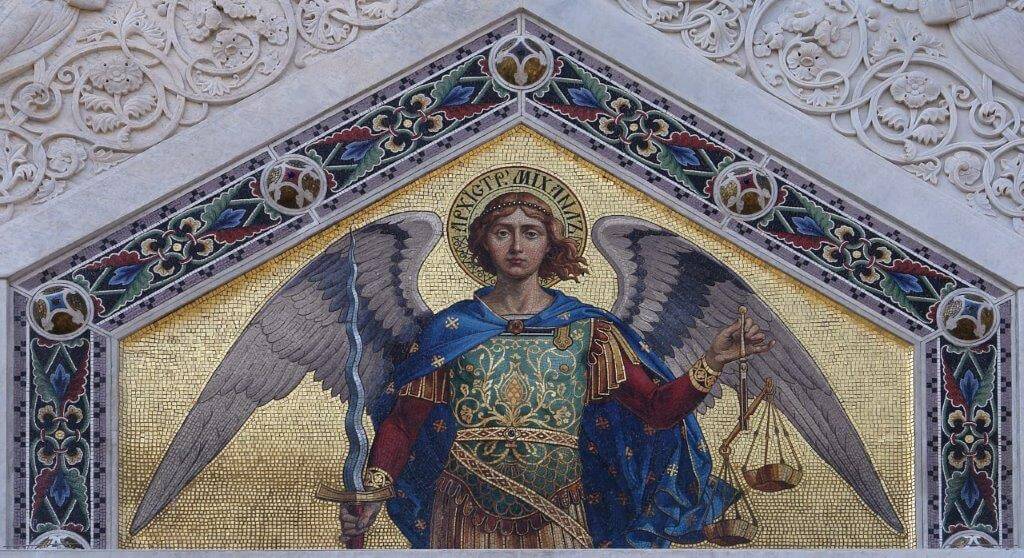In 1717 and 1719 Emperor Charles VI of Austria issued two charters which gave Trieste the status of a Free Port (Porto Franco) and various other privileges, as well. These special circumstances favoured the settlement of traders from all over Europe. Charles’s successor, Empress Maria Theresa of Austria, increased these privileges even more by issuing two significant charters on January 9th 1745 and April 27th 1769.
Documents show that the first Serbs settled in Trieste as early as in 1736. They were merchants by profession, coming from Herzegovina, Bosnia, Montenegro and Dalmatia, but soon enough they were followed by the Serbs from the regions of Syrmia, Banat and Lika. At the same time the first merchants from Greece began settling in Trieste, as well.
The charter issued by Empress Maria Theresa on February 20th 1751 granted the local Greeks the right to establish their own religious community and to build a Greek church in Trieste (the original of the document is kept on the premises of Serbian Orthodox Religious Community in Trieste, further in the text “SORC”). The construction of the church began that same year
The Serbs from Trieste, craving in this foreign land for an orthodox church where they could pray to God, joined immediately their Greek brethren in faith, helping them financially in building the church. For this reason, two Serbs sat on the Church Construction Board. The Church was dedicated to the St. Spyridon Thaumaturge
The year 1756 saw the establishment of the Greek-Serbian Religious Community in Trieste. The Assembly of its Brotherhood that convened on August 30th 1772 approved its first Statute. It was officially confirmed by Empress Maria Theresa on February 28th 1773.
At a certain point a disagreement arose between the Serbs and the Greeks with regards to the priest performing the Holy Liturgy and the language in which it was celebrated. Namely, it was only the Greek priest that celebrated Liturgies and the Serbs were “always sad for not having a Serb priest” who would serve “in their beloved language”. The Royal Rescript from March 1st 1781 put an end to these discordances by resolving that the Holy Liturgies in the Church of St. Spyridon were to be celebrated by both Greek and Serb priest, in Greek and in Old Slavic language alternately.
As a consequence, the Greeks, unhappy with this royal decision, left the Community on Maundy Thursday 1781. The definitive separation from the Serbs was confirmed by a Decree issued by the Governor of Trieste on April 2nd 1782. From this point on the Greek and the Serbian Community in Trieste led separate religious lives, though always in mutual brotherly love and harmony.
After the Greeks separated themselves, the Serbs kept the church they had built with joint forces, paid the Greeks their share and completed its decoration. Since the church was built on an unstable ground where saltworks once stood, in time it began “shaking”, with “the towers swinging” and ”the walls cracking”, as reported in the documents from that time. For this reason, the SORC’s Executive Board decided in 1858 to tear the church down and build a new one, bigger and more beautiful, on the same location.The demolition took place in the spring of 1861, while the construction of the new, present-day church followed immediately. Dedicated also to the St. Spyridon Thaumaturge, it was finished and consacrated in 1869.

The Assembly of the Brotherhood of the Serbian Community convened on September 1st 1793 and put forth the new Regulations-Statute which contained only minor differences with respect to the Statute from 1773. The full title of this document read: „Statutes and Regulations of the Illyrian Nation and Brotherhood settled in the Town and the Free Port of Trieste” (“Установљенија и Правила Нацие и братства Илирическаго утврждена года 1748 у граду и пристанишчу слободнаго Тријеста“) or according to the translation by Vuk Stefanović Karadžić: “Statutes and Regulations of the Serbian People and its Brotherhood in the Town and the Free Port of Trieste ”. Regulations-Statute was approved in 1793 by Emperor Francis II and was in force until 1929, that is until 1950, when it became clearly evident that the document was out-of-date and that the time came, as the historian Dr. M. Purković wrote, for it to be adapted to the spirit of the time.
On July 20th 1925 the Kingdom of Italy and the Kingdom of Serbs, Croats and Slovenes signed in Nettuno the “Agreement on the Serbian Orthodox Religious Community”. Before that two other agreements had been signed (in Rome, on January 27th 1924 and July 2nd 1924). According to this Convention (further in the text the “Nettuno Convention”) the Statute from 1793 was abrogated, the SORC lost its Serbian and Orthodox character, acquiring, as stated in the Article 2 of the Convention, “a character of a people’s Serbo-Croat-Slovenian religious institution”. The right of control over it passed from the Kingdom of Italy to the Kingdom of Serbs, Croats and Slovenes (Article 2).
Based on the Article 5 of the Nettuno Convention and upon invitation of the Royal Yugoslav Consulate in Trieste (num. 701 from November 28th 1928 and num. 56 from December 12th 1928), the Community’s Executive Board convened on December 12th 1928, and “drew up” the new Regulations-Statute, although this was not within its competence. Instead, it should have been voted by the Assembly of the Brotherhood. The new Regulations (“Regulations of the Serbian-Orthodox Community of St. Spyridon in Trieste“) were approved by the President of the Council of Ministers and by the Minister of Foreign Affairs of the Kingdom of Yugoslavia on April 22nd 1929 (decree num. 3352) and blessed by the Holy Synod of the Serbian Orthodox Church (Syn. num. 675/Rec. 473 from April 11th 1929). As the Article 2 reads, the Yugoslav character of the Serbian Religious Community is once again confirmed: «Serbian Religious Community in Trieste and its institutions have a character of a Serbo-Croat-Slovenian people’s institution». Based on the Nettuno Convention and on these Regulations, the right of control over the Community passed from the Kingdom of Italy to the Kingdom of Serbs, Croats and Slovenes. The Executive Board’s sessions were occasionally attended by the Yugoslav Consul or his envoy as a “representative of the Royal Government” through whom the Kingdom of Yugoslavia exerted its right to a control. In this way, the Serbian Religious Community was de facto denied its right to autonomy. The approvation of the new Statute on December 12th 1928 by the Community’s Executive Board, an unrightful act given that this falls under the sole and exclusive jurisdiction of the Assembly of the Brotherhood, as regulated by our Founding Fathers’ Statute, confirmed only more that the Community was deprived of its autonomy . The SORC was governed by this Statute until the beginning of the Second World War.
The turbulent and disastrous historical events during the 20th century taking place all around the world swept through entire Europe causing deep and tumultuous changes. The SORC of St. Spyridon in Trieste was greatly affected by the consequences of these events.
Since the «Nettuno Convention» was never ratified by the Kingdom of Italy, after the beginning of the Second World War in Yugoslavia on April 6th 1941 Italy named a commissioner who governed the Community until the end of the War. The situation changed when the Yugoslav Communists entered Trieste.
They chose a new commissioner, Velimir Đerasimović, a school teacher from Trieste. This period is known as one of the hardest times in the history of the Community. In 1944 the Yugoslav Communists, known as enemies of the Serbian Orthodox Church, killed the priest Petar Vojinović and his wife Milka.

The political situation changed after the Partisans left Trieste and the Community’s Brotherhood convened on October 10th 1948. On this occasion, it was agreed that the 1793 Statute was out-of-date and the one approved in 1928 was unacceptable and invalid for the Brotherhood. Thus the Assembly took on the task of implementing necessary changes and amendments to the Statute from 1793 and approved the new Statute on August 28th 1949.
The Community was governed by this Statute until 1967 and its autonomy and religious and charitable mission in the spirit of the Orthodox religion were successfully protected. However, since the Statute had to be in compliance with the Italian state laws, certain adaptations had to be made on several occasions. The process of introducing thorough and significant changes was started only in 1966.
By a decree of the President of Italy the new Statute came into effect on January 16th 1967. Thanks to this document the institution of brotherhood and the Community’s autonomy established by its founding fathers were preserved.
The institution of brotherhood in the Serbian Orthodox Church has disappeared over time and the one still existing in our Community is a historical rarity, a unique and glorious example of the faithful united in the bosom of their Church actively contributing to its well-being. What must be said is that the SORC, in order to preserve its historical role and to protect itself from the Communist regime in Yugoslavia, with the 1967 Statute joined the Serbian Orthodox Church in the free world.
Two attempted abductions of the Community’s President, Dragoljub Vurdelja, show how much this bothered Josip Broz Tito and his regime. The SORC remained a part of the autonomous Serbian Orthodox Church in the free world until 1989, the year when by the decision of its Brotherhood, but especially by merit of its late President, Dušan Šain, it returned under the jurisdiction of its mother Church in Belgrade. There is a great deal of undeniable evidence that the mother Church, that is the Patriarchate in Belgrade and certain bishops, keep trying to annull our Founding Fathers’ Statute and to eliminate the autonomy of this Religious Community of crucial importance for the Serbs outside their homeland.

Autonomous by the power of our Statute, we members of the Serbian Orthodox Religious Community and its Brotherhood, today as for the last 260 years, keep preserving our Orthodox religion and our Founding Fathers’ legacy. Determined to continue doing so even in days to come, we remain willing and ready to cooperate with all institutions and other religious communities, in accordance with our Statute and the laws of the Republic of Italy.




